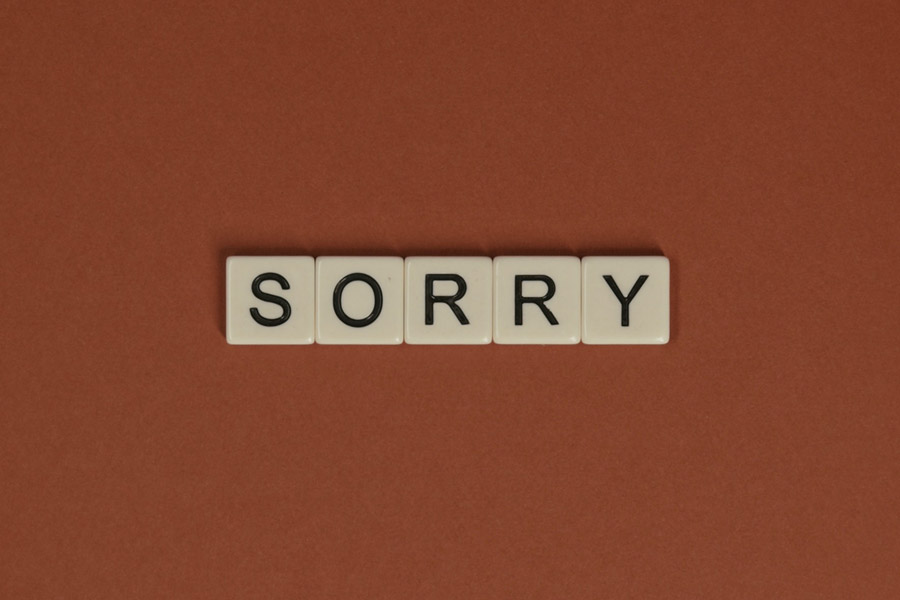Do you find it hard to say ‘Sorry’?
When was the last time you said it? When was the last time you said it to someone at work?
Apologising is not as simple as it seems.
It’s enough of an issue that there are songs written about how hard it is to say, and an entire sector of the greeting card industry dedicated to avoiding saying it in person.
Not all apologies are created equal
In Barbara Kellerman’s article When should a leader apologise – and when not? she says: “People speak of ‘a simple apology’ – but there is no such thing. To acknowledge a transgression, seek forgiveness and make things right is a complex act. Apologies are prompted by fear, guilt and love — and by the calculation of personal or professional gain. They are shaped by culture, context, and gender. They are base and self-serving or generous and high-minded.”
That’s a lot resting on the shoulders of one small word. And that’s because it’s not the word itself, but the intention behind it that really matters.
Saying sorry is not a strategy
As leaders, we know that building and maintaining trust is key. We also need to remember that we are human, as well as leaders. We will make mistakes. Which means it’s critical to also know how to re-build trust and apologise well.
I’m not talking about grand gestures of public apology – that’s a topic for another article entirely. I’m talking about a way of working and being. Of ensuring we behave with personal integrity and care towards the people we lead and work with. I’m talking about leading in a way that is authentic, accessible and vulnerable. I am definitely not talking about apologising as a ‘tool’.
We make a genuine apology when we care about the person and the relationship we have with that person. It’s an act of care.
In his article What a real apology requires Joseph Grenny notes that: “Most of what has been written about apologies is fundamentally manipulative, because the focus is on technique — on applying psychology to extract forgiveness from others. As in: ‘What do I need to say in order to get my boss/child/neighbor to trust me again?’ This view of apologies is one of today’s most pernicious assaults on trust. At its best, an apology is the fruit of personal change, not a tool for interpersonal persuasion.”
Sorry for the way I said sorry…
In his article The Four Types of Ineffective Apologies, Andy Molinsky notes that: “It’s hard to admit our transgressions — to look someone in the eye and offer a sincere apology. But apologies are essential for repairing relationships in the workplace. And, as leaders, we need to be able to coach our team on giving and receiving apologies effectively.”
Molinsky outlined four ways we make our apologies ineffective, when we’re not clear on our intention. Take a moment to think about where you might have employed one of the below sub-standard apologies, or been on the receiving end of one:
1. The Empty Apology. “I’m sorry. I said I’m sorry.” The empty apology is going through the motions, with no genuine feeling behind it – which is the message the receiver will actually get, even though you have technically apologised.
2. The Excessive Apology. “I’m so sorry! I feel so bad. I’m so sorry. Is there anything I can do? I feel so bad about this…” Excessive apologies end up drawing the attention to your own feelings, rather than to what you’ve done to the other person. It could be too much emotion relative to the situation, or that you apologise so many times the receiver feels compelled to say it’s ok, defeating the purpose of the apology.
3. The Incomplete Apology. “I’m sorry that this happened.” An effective apology has three key components: taking responsibility for your role in a situation or event, and expressing regret; asking forgiveness; and promising it won’t happen again (or that you’ll at least try to prevent it in the future). The incomplete apology touches on a few, but not all of these elements, making it incomplete and therefore, ineffective.
4. The Denial. “This simply wasn’t my fault.” Frustration, anger and ego get in the way and you fail to apologise at all. Denial does little to repair a fractured relationship and is actually more likely to further damage it.
The key to all of this is to focus on your intention when you are apologising. If you are going to the effort – and discomfort – of saying sorry, do it properly; with good grace and will.
Know your why and apologise well
Key to apologising well is controlling our own emotions. Whilst a timely apology is important, ensuring you are calm and clear on why you are apologising is even more critical.
To do this, we have to battle with strong emotions: our shame or guilt attached to what we have done; a sense that it is not all our fault (that we are only partly to blame); fear of the other person’s reaction, including their possible rejection of our apology and heated response.
There’s not a lot of use trying to remember an over-complicated process when we are emotionally heightened. So, just think about the key steps below and focus on your ‘why’ – why you are apologising and why the relationship is important to you, and coach your team to do the same. Ultimately an effective apology is an honest appeal for forgiveness backed up by how you act going forward.



